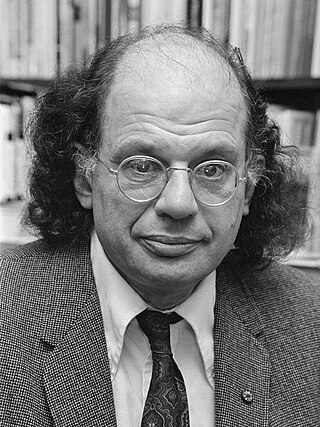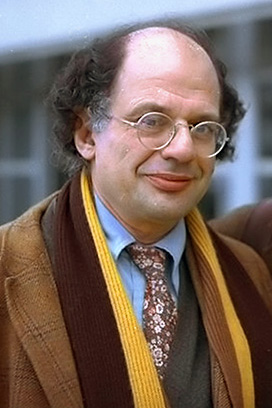This article has multiple issues. Please help improve it or discuss these issues on the talk page . (Learn how and when to remove these messages)
|

Jim Cohn is a poet, poetry activist, and spoken word artist in the United States.
This article has multiple issues. Please help improve it or discuss these issues on the talk page . (Learn how and when to remove these messages)
|

Jim Cohn is a poet, poetry activist, and spoken word artist in the United States.
Cohn was born in Highland Park, Illinois, in 1953. He received a BA from the University of Colorado at Boulder in English (1976) and a Certificate of Poetics (1980) from the Jack Kerouac School of Disembodied Poetics at Naropa University where he was a teaching assistant to Allen Ginsberg. He received his M.S. Ed. in English and Deaf Education from the University of Rochester and the National Technical Institute for the Deaf (NTID) in 1986. For over two decades, he worked in the field of disability services, taking a siddha approach as a model of Disability Services and Studies practice and scholarship. He believed that the social sciences should be redefined thematically within the United States into a form of American Karmic Studies.[ clarification needed ]
In 1980, Cohn published his first collection of poems, Green Sky. In 1989 Prairie Falcon was published by North Atlantic Books. He has published five more books of poetry and two works of poetics nonfiction.
He introduced Allen Ginsberg to Deaf poets at NTID in 1984. In 1986, he published an essay entitled "The New Deaf Poetics: Visible Poetry" in Sign Language Studies (52). [1] In 1987, he coordinated the first National Deaf Poetry Conference, in Rochester, NY. [2] His role in the history of American Sign Language (ASL) poetics was documented in a 2009 film by Miriam Nathan Lerner entitled The Heart of the Hydrogen Jukebox. [3]
In 1990, he became editor to an annual poetry magazine, Napalm Health Spa. [4] In 2013 the magazine released an anthologic special edition of Napalm Health Spa, "Long Poem Masterpieces of the Postbeats". [5] His entry was "Treasures For Heaven" [6]
In 1995, Cohn began recording with The Abolitionists, [7] a North Bay Area band that featured Mooka Rennick and guitarist Steve Kimock. He began a solo recording artist career beginning with Unspoken Words in 1998. From 2006-2008, he worked on homage, a spoken word and music recording made upon the death of his mother. In 2009, he released Impermanence, a double CD compilation.
In 1996, Cohn began planning for an online poetry project that would explore Beat Generation influences on the Postbeat Poets. In 1997, he founded the on-line Museum of American Poetics. In 1999, MAP became the first online poetry site to be mentioned in the New York Times . Cohn published his first collection of prose the same year, exploring the theoretical parallels between ASL and modernist poetries in a book entitled Sign Mind: Studies in American Sign Language Poetics. [8]
Cohn's first video production, the American Poet Greats series, won the Best Multimedia Award from Community Television in Boulder, Colorado three years in a row (2001-2003). In 2003, Cohn produced his first film, a 55 minute profile on the life and poetic contributions of the Jack Kerouac School co-founder Anne Waldman, entitled Anne Waldman: Makeup on Empty Space.
In a 2011 review of Cohn's Sutras & Bardos: Essays & Interviews on Allen Ginsberg, the Kerouac School, Anne Waldman, The Postbeat Poets & the New Demotics, Beat Studies scholar Jonah Raskin wrote "Perhaps no one in the United States today understands and appreciates the poetic durability and the cultural elasticity of the Beats better than Jim Cohn." [9]
This article's use of external links may not follow Wikipedia's policies or guidelines.(January 2022) |

Irwin Allen Ginsberg was an American poet and writer. As a student at Columbia University in the 1940s, he began friendships with Lucien Carr, William S. Burroughs and Jack Kerouac, forming the core of the Beat Generation. He vigorously opposed militarism, economic materialism, and sexual repression, and he embodied various aspects of this counterculture with his views on drugs, sex, multiculturalism, hostility to bureaucracy, and openness to Eastern religions.

The Beat Generation was a literary subculture movement started by a group of authors whose work explored and influenced American culture and politics in the post-World War II era. The bulk of their work was published and popularized by Silent Generationers in the 1950s, better known as Beatniks. The central elements of Beat culture are the rejection of standard narrative values, making a spiritual quest, the exploration of American and Eastern religions, the rejection of economic materialism, explicit portrayals of the human condition, experimentation with psychedelic drugs, and sexual liberation and exploration.

"Howl", also known as "Howl for Carl Solomon", is a poem written by Allen Ginsberg in 1954–1955 and published in his 1956 collection Howl and Other Poems. The poem is dedicated to Carl Solomon.

Performance poetry is poetry that is specifically composed for or during a performance before an audience. It covers a variety of styles and genres.

Gregory Nunzio Corso was an American poet and a key member of the Beat movement. He was one of the youngest of the inner circle of Beat Generation writers.

Anne Waldman is an American poet. Since the 1960s, Waldman has been an active member of the Outriders Poetry Project experimental poetry community as a writer, performer, collaborator, professor, editor, scholar, and cultural/political activist. She has also been connected to the Beat Generation poets.

The term San Francisco Renaissance is used as a global designation for a range of poetic activity centered on San Francisco, which brought it to prominence as a hub of the American poetry avant-garde in the 1950s. However, others felt this renaissance was a broader phenomenon and should be seen as also encompassing the visual and performing arts, philosophy, cross-cultural interests, and new social sensibilities.
When I Was Cool: My Life at the Jack Kerouac School is Sam Kashner's autobiographical account of his experience as the first student at the Jack Kerouac School of Disembodied Poetics, which was founded by Allen Ginsberg and Anne Waldman in honor of their late friend, Jack Kerouac. As he describes in his book, Kashner was a disgruntled Long Island teenager in the 1970s who was obsessed with the poetry and prose of the Beat generation of the 1950s.

John Joseph Wieners was an American poet.

Peter Anton Orlovsky was an American poet and actor. He was the long-time partner of Allen Ginsberg.

The City Lights Pocket Poets Series is a series of poetry collections published by Lawrence Ferlinghetti and City Lights Books of San Francisco since August 1955.
Clayton Valli was an American prominent deaf linguist and American Sign Language (ASL) poet whose work helped further to legitimize ASL and introduce people to the richness of American Sign Language literature.

Mexico City Blues is a long poem by Jack Kerouac, composed of 242 "choruses" or stanzas, which was first published in 1959. Written between 1954 and 1957, the poem is the product of Kerouac's spontaneous prose technique, his Buddhist faith, emotional states, and disappointment with his own creativity—including his failure to publish a novel between 1950's The Town and the City and the more widely acclaimed On the Road (1957).

Reality Sandwiches is a book of poetry by Allen Ginsberg published by City Lights Publishers in 1963. The title comes from one of the included poems, "On Burroughs' Work": "A naked lunch is natural to us,/we eat reality sandwiches." The book is dedicated to friend and fellow Beat poet Gregory Corso. Despite Ginsberg's feeling that this collection was not his most significant, the poems still represent Ginsberg at a peak period of his craft.

"A Supermarket in California" is a poem by American poet Allen Ginsberg first published in Howl and Other Poems in 1956. In the poem, the narrator visits a supermarket in California and imagines finding Federico García Lorca and Walt Whitman shopping. Whitman, who is also discussed in "Howl", is a character common in Ginsberg's poems, and is often referred to as Ginsberg's poetic model. "A Supermarket in California", written in Berkeley about a market at University Avenue and Grove Street in that city and published in 1956, was intended to be a tribute to Whitman in the centennial year of the first edition of Leaves of Grass.
American Sign Language literature is one of the most important shared cultural experiences in the American deaf community. Literary genres initially developed in residential Deaf institutes, such as American School for the Deaf in Hartford, Connecticut, which is where American Sign Language developed as a language in the early 19th century. There are many genres of ASL literature, such as narratives of personal experience, poetry, cinematographic stories, folktales, translated works, original fiction and stories with handshape constraints. Authors of ASL literature use their body as the text of their work, which is visually read and comprehended by their audience viewers. In the early development of ASL literary genres, the works were generally not analyzed as written texts are, but the increased dissemination of ASL literature on video has led to greater analysis of these genres.
Cedar Sigo is a Suquamish American writer of art, literature and film.

Christian Ide Hintze was an Austrian poet and performance artist, who focused on the transition from literary to cross-media forms.
Albert Fairchild Saijo was a Japanese-American poet associated with the Beat Generation. He and his family were imprisoned as part of the United States government's internment of Japanese Americans during World War II, during which time he wrote editorials on his experiences of internment for his high school newspaper. Saijo went on to serve in the U.S. Army and study at the University of Southern California. Later he became associated with Beat Generation figures including Jack Kerouac, with whom he wrote, traveled and became friends.
Fast Speaking Music is a label founded by poet Anne Waldman and Ambrose Bye, in New York City. Releases by Fast Speaking Music have prominently featured jazz, the literary, and performance art. Its recordings have been made featuring poets, musicians, and interdisciplinary artists such as Anne Waldman, Amiri Baraka, Clark Coolidge, Meredith Monk, Akilah Oliver, Thurston Moore, Thomas Sayers Ellis, and many others. Variously associated with contemporary poetry, Conceptual Poetics and Conceptual Art, the Beat Generation, New York School, Black Arts Movement, New American Poetry, Nuyorican Poetry, Abstraction, Dematerialized Art, rock & roll, jazz, and experimental music and cinema, artists in the Fast Speaking Music catalog have roots that stretch across a broad spectrum of disciplines and art practices ranging from letters to music, dance, film and visual arts. Musicians featured on the label include Daniel Carter, Ha-Yang Kim, Devin Brahja Waldman, Max Davies, and Thurston Moore.
{{cite web}}: CS1 maint: archived copy as title (link)